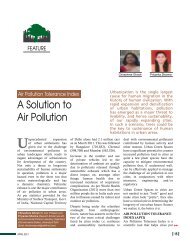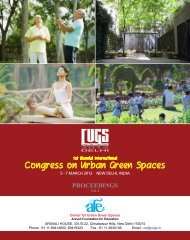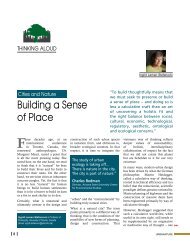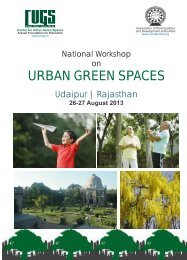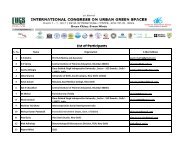Sustainability and the City - Center for Urban Green Spaces
Sustainability and the City - Center for Urban Green Spaces
Sustainability and the City - Center for Urban Green Spaces
Create successful ePaper yourself
Turn your PDF publications into a flip-book with our unique Google optimized e-Paper software.
Workplace <strong>Green</strong>sProductivity with HealthThe existing vegetation around <strong>the</strong>boundary wall was retained <strong>and</strong> twoadditional rows of trees were plantedall along <strong>the</strong> boundary to providea dense cover of tress to enhanceaes<strong>the</strong>tic appeal of <strong>the</strong> building fromoutside <strong>and</strong> green view from officewindows.Responsibility <strong>for</strong> lookingafter each new tree planted has beenassigned to a member of <strong>the</strong> work<strong>for</strong>ceto create a sense of belonging. Twolarge lawns, dotted with tree speciescapable of developing into very largetrees, were also developed at <strong>the</strong>front of <strong>the</strong> building to provide asoothing view to <strong>the</strong> work<strong>for</strong>ce <strong>and</strong><strong>the</strong> visitors. These lawns are alsoused by <strong>the</strong> office personals to have<strong>Green</strong>way leading to office buildingsmall walks or to just relax <strong>for</strong> a fewminutes. Ef<strong>for</strong>ts have been made thatone should be able to have periodicvisual exposure of one or <strong>the</strong> o<strong>the</strong>relement of green space from most of<strong>the</strong> office rooms.As noted earlier, an important featureof <strong>the</strong> green space is plantation oflocal key-stone species of tress suchas peepal (Ficus religiosa), neem(Azadirachta indica), <strong>and</strong> bargad(Ficus benghalensis) which are likelyto develop large canopies once fullydeveloped. It is a well establishedfact that humans feel awe-inspiredduring rest or walk beneath suchlarge-canopied tress. These trees aregrowing very well <strong>and</strong> it is hopedthat in coming years, <strong>the</strong>y will fur<strong>the</strong>renhance <strong>the</strong> beauty of <strong>the</strong> building<strong>and</strong> provide com<strong>for</strong>t to its occupants.Ficus trees are among <strong>the</strong> cultural <strong>and</strong>ecological keystone as well as usefulin urban air pollution mitigation.Several species of frugivorous birds<strong>and</strong> bats are likely to visit large Ficustrees contributing to biodiversityconservation in human-dominatedl<strong>and</strong>scapes. Likewise, multiple-useneem trees are a regular element ofurban systems across dry regionsof <strong>the</strong> world. To enhance <strong>the</strong>habitat heterogeneity of <strong>the</strong> greenspace, tree-like structures made ofrein<strong>for</strong>ced cement concrete have alsobeen erected along both sides of <strong>the</strong>short drive-way leading from mainentrance to <strong>the</strong> lobby, <strong>and</strong> in <strong>the</strong>front parking area. These structuresare now covered with thick foliage ofvarious species of climbers providingliving canopy to drive-way <strong>and</strong> <strong>the</strong>parking place.In coherence with evidence-basedinsights on developing small urbangreen spaces <strong>for</strong> health, happiness<strong>and</strong> stress reduction, <strong>the</strong> RSPCBworkplace green space has 5 keyelements that make it useful <strong>for</strong> all.These are:• Heterogeneity <strong>and</strong> richness of naturalelements: grass, flowering herbs, shrubs<strong>and</strong> climbers, variety of tree species, greenisl<strong>and</strong>s, <strong>and</strong> rows of mixed vegetationalong with climber-canopies. In literature,<strong>the</strong>se natural elements are suggestedto contribute <strong>the</strong> most to high ratingson restoration, health <strong>and</strong> relaxationoutcome. Preservation of existing trees<strong>and</strong> vegetation fur<strong>the</strong>r add to habita<strong>the</strong>terogeneity <strong>for</strong> birds <strong>and</strong> butterflies <strong>and</strong>enhanced visual appeal as a moderatelydense vegetation.• Design with a sense of security <strong>and</strong>place-identity: enclosed boundaries,good seating pockets on natural grass,openness, potential to enjoy sun & shadeat will, socialising corners, <strong>and</strong> sittingpockets that face natural elements. Themost liked elements that help in stressreduction are structural components suchas combination of grass, shrubs, trees, <strong>and</strong>July 201319



